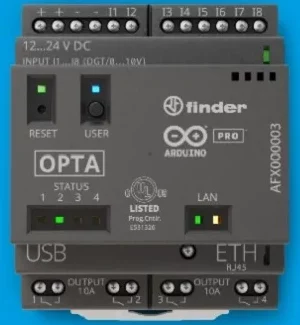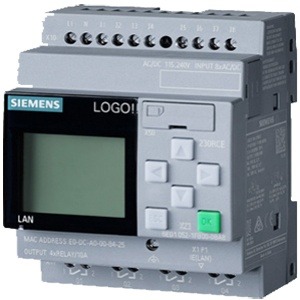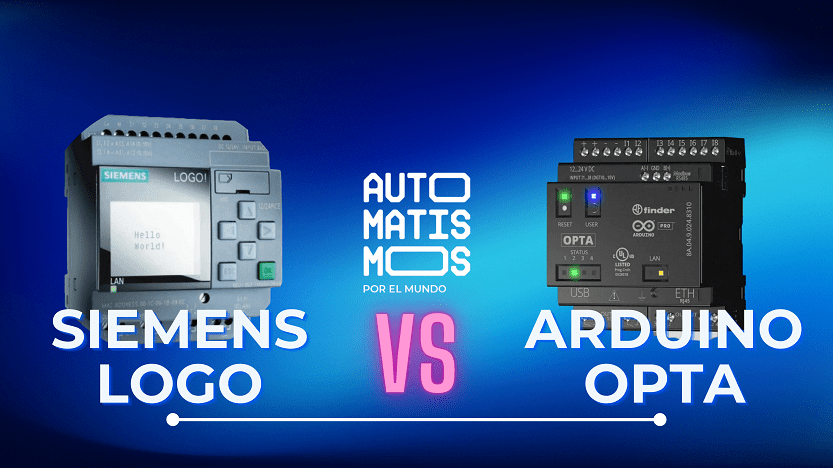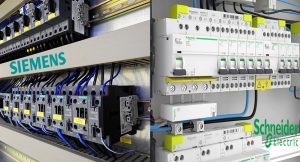Recently Finder, in a collaboration with Arduino, have released their first Programmable Logic Relay: The Finder/Arduino OPTA. If you don’t know what I’m talking about I recommend that before continuing with this article, take a look at our review so you can understand it better.
Arduino Opta: A LOGO more than a PLC!
If you already have it clear, then you know that the OPTA has many technical and physical similarities with the Siemens LOGO!, and this is why I find it very interesting to create a comparison between these two devices. So if you want to know which one comes out victorious stay until the end of the article.
Without further ado, let’s get started!
Is the Arduino OPTA the same as the Siemens LOGO!
As I mentioned before, the Arduino OPTA is a Programmable Logic Relay or a low performance PLC just like the Siemens LOGO! The latter was created a few years ago and has been updated several times increasing its operational capabilities, but never reaching the category of Industrial PLC. If you have doubts about these concepts that I comment above, these two articles that I leave you below are perfect to understand what I have told you above:
Once you have all of the above understood, you will already know that we are under a pretty fair comparison between two very interesting and versatile opponents.
Massive lack of knowledge about Arduino OPTA!
I want to make a small analysis about the incredible rejection linked to ignorance and ignorance surrounding Arduino and its recently launched “PLC”. When we did our review on the Youtube Channel and TikTok we received many comments from users who simply stated that Arduino was only worth to learn and make very simple projects, but without any data to support their claim, pure fanatic hate without sense. If you are reading this article and you are one of those who think this way, I invite you to leave me in the comments your opinion, but arguing it with proven data and your REAL personal experience on this topic. Let’s have a healthy debate among all of us, where we can have our different ways of thinking, but always with objectivity and respect.
I don’t pretend that this “new” product will turn around the industrial automation industry as we know it, nor that all the old equipment will be replaced by newer equipment like this. But I do think that Arduino has taken a giant step hand in hand with Finder to bring a device categorized as Industrial, to compete, or at least bring if vision of problem solving to the traditional PLC market.
Having made the above clear, let’s go with what everyone wants to see: the comparison.
Arduino OPTA vs Siemens LOGO!
In this comparison of the Arduino OPTA vs the Siemens LOGO! I will make clear their main technical and physical characteristics. At the end of this comparison you will be able to create your own criteria a little more focused on real official data offered in the datasheets published by both manufacturers. Let’s get down to business!
 |
 |
|
Power Supply Voltage |
12…24 VDC | 12…24 VDC |
Display |
No | Yes, there is also a version without display. |
Inputs |
8 analog/digital inputs (configurable) | 8; 4 of them suitable as analog E (0 to 10 V) |
Outputs |
4 outputs | 4 outputs |
Tipe of Outputs |
Relay, maximum current 10A | Relay, maximum current 10A |
Processor |
Dual-core ST STM32H747XI processor | No data published in data sheet |
RTC |
240 | 400 |
Programming Methods |
Arduino + IEC-61131-3 (LD – SFC – FBD – ST – IL) | FUP-KOP-UDF |
Communication |
TCP/IP, MODBUS TCP, MODBUS RTU, Wi-Fi 2.4 GHz and Bluetooth 4.2 | S7, NTP, MODBUS TCP, MQTT |
Dimensions |
Height: 88.8 , Width: 70, Depth: 60.8 | Height: 90 , Width: 71.5 , Depth: 60 |
Certifications |
CE, CB, WEEE, ENEC, REACH, UKCA, FCC, cULus | CE, CSA, UL, FM, IEC 61131, VDE 0631, Naval approvals |
Protection Index (IPxx) |
IP20 | IP20 |
Conclusions
You have already seen the comparison between these two devices. For this article I am going to reserve my final opinion regarding my consideration of which device would be better. Instead I just want to draw attention to the many similarities that a, according to many, “learning” device has with a device for industrial use. You also noticed that price was not a comparative factor as it is not an objective or technical data.
This is an article in which I would very much like to read your comments and opinions on this topic, as I know this issue is going to generate a lot of controversy among the Community.
For now, if you have come this far it means that you have been interested in what you have read, so I ask you to leave me a Like. Comment what you thought and if you already have experience with any of these two devices. Remember that we have an Official Content Dissemination Channel where we are constantly publishing.
Without further ado, I bid you farewell until the next article.





You forget about scalability. That way a logo can have a lot of inputs and multiple types of outputs like digital outputs. (Basically to use more proprietary stuff). Does arduino have that capability?